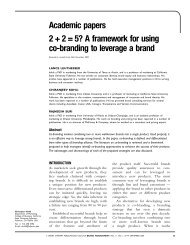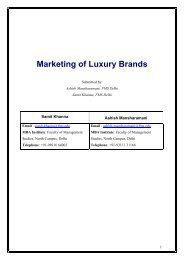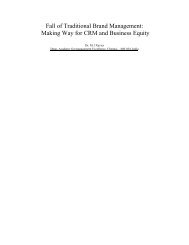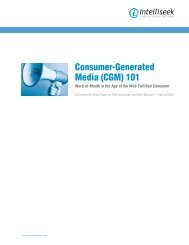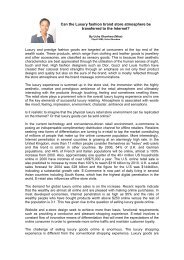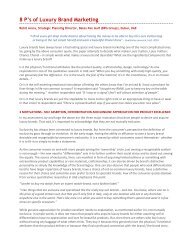Fwd: This Made Me Laugh - Brandchannel
Fwd: This Made Me Laugh - Brandchannel
Fwd: This Made Me Laugh - Brandchannel
You also want an ePaper? Increase the reach of your titles
YUMPU automatically turns print PDFs into web optimized ePapers that Google loves.
<strong>Fwd</strong>: <strong>This</strong> <strong>Made</strong> <strong>Me</strong> <strong>Laugh</strong><br />
How Viral Ad Parodies Impact Your Brand<br />
©2002 Harvest Communications LLC
Harvest Communications LLC <strong>Fwd</strong>: <strong>This</strong> <strong>Made</strong> <strong>Me</strong> <strong>Laugh</strong> Table of Contents<br />
Table of Contents<br />
Introduction 01<br />
He who laughs last<br />
Why should you care?<br />
Four Key Questions to Ask 03<br />
From benign to brazen: when parodies stop being funny.<br />
1. Who/What is the target of the parody?<br />
2. What is the intent behind the parody?<br />
3. What is the breadth of the parody?<br />
4. What is the source of the parody?<br />
Using Parodies to Dissect Consumer Opinions 10<br />
Product or service dissatisfaction.<br />
Embracing the David inside every Goliath. Is bigger always better?<br />
Corporate responsibility: Talk the talk. Walk the walk.<br />
Conclusion 13<br />
Brand Parody ToolKit 14<br />
The spoof self-assessment<br />
The brand parody action plan<br />
Five ways to respond<br />
Sources and References 17<br />
Contact Us 19<br />
©2002 Harvest Communications LLC
Harvest Communications LLC <strong>Fwd</strong>: <strong>This</strong> <strong>Made</strong> <strong>Me</strong> <strong>Laugh</strong> Introduction Page 01<br />
Our web-based research uncovered<br />
over 200 different advertising<br />
spoofs ranging from simple logo<br />
morphing to more elaborate,<br />
complete reproductions of existing<br />
commercial campaigns.<br />
Introduction<br />
He who laughs last<br />
Nothing feels as good as laughter…that is, unless you or your brand is the butt of the joke. And, while<br />
advertisers have long used humor as a means of grabbing consumer attention, these days, creative<br />
consumers use humor to poke fun at advertisers and the brands they publicize, and often to make<br />
a statement.<br />
Call them what you will–brand parodies, brand spoofs, parody advertising or spoof marketing, they are<br />
born when a brand is the actual source of the humor. They come in all shapes and sizes. Jpeg’s. Gif’s.<br />
Mpeg’s. Avi’s. Script’s. Flash. We read. We laugh. We forward.<br />
“Indecent Proposal”<br />
A MasterCard Priceless Campaign Parody<br />
www.ifilm.com<br />
©2002 Harvest Communications LLC<br />
“Bill Gates makes the switch to MAC”<br />
www.macboy.com<br />
“America Off-line”<br />
www.ifilm.com
Harvest Communications LLC <strong>Fwd</strong>: <strong>This</strong> <strong>Made</strong> <strong>Me</strong> <strong>Laugh</strong> Introduction (continued) Page 02<br />
Introduction (continued)<br />
Why should you care?<br />
Brand Builder and Brand Microscope. Parodies are becoming a popular way for people to vent and<br />
voice their opinions. They have the potential to play an important role in branding and product<br />
development strategies. Beyond laughter and amusement, they provide a unique look into the mind<br />
of the consumer.<br />
When a parody is positive, you may benefit from viral marketing extending your brand in the most<br />
authentic way–driven by customers. When a parody is negative or controversial, you have insight<br />
about customer dissatisfaction, product or service flaws or public opinion that could lead to negative<br />
public relations.<br />
Easy to Make. Easy to Spread. While parodies in the early days were created by professionals<br />
(who doesn’t remember the Saturday Night Live spoofs?), today, anyone with a computer, a sense<br />
of humor and a point of view can create their own professional looking advertising spoof. With a compelling<br />
and pervasive medium like the Internet, they’re even easier to spread. For example, shortly after PWC<br />
Consulting decided to rename itself “Monday,” the firm was acquired by IBM. Within 12 hours after the<br />
announcement, spoofs were spreading rapidly by email. In one of parodies, the company is renamed<br />
a different day of the week: “Tuesday: You wake up, IBM buys you.”<br />
Assessing the Impact on Your Brand. We’ll look at the four key questions to ask when looking at a parody,<br />
and give you some tools to assess if a parody is impacting your brand–positively or negatively–and<br />
when to laugh, learn or respond.<br />
©2002 Harvest Communications LLC
Harvest Communications LLC <strong>Fwd</strong>: <strong>This</strong> <strong>Made</strong> <strong>Me</strong> <strong>Laugh</strong> Four Key Questions to Ask Page 03<br />
Four Key Questions to Ask<br />
From benign to brazen: when parodies stop being funny.<br />
Of course not all spoofs are negative. Some have been developed simply for fun with no intention of<br />
harm or dissolution of brand. For instance, there are over 70 knock-offs of the Budweiser WHASSUP!<br />
campaign scattered throughout the web 1 . One of the websites even offers tips on how to make your<br />
own parody. MasterCard’s Priceless campaign is another favorite of the parody community with<br />
numerous popular takes circulating on the Web. In these cases, the spoofs pose little threat to brand<br />
integrity and may even positively enhance brand presence. However, not all spoofs are so good-natured–<br />
and that’s the challenge.<br />
What is the fine line between serious and funny? While many would say that picking the dangerous<br />
ones is an exercise in subjectivity and the intangible, we found four key areas of focus to help determine<br />
if parodies are in the brand danger zone.<br />
Is Your Brand in the Danger Zone?<br />
Here are four key areas of focus<br />
1. Who/What is the target of the parody?<br />
2. What is the intent behind the parody?<br />
3. What is the breadth of the parody?<br />
4. What is the source of the parody?<br />
1. Nickell, Joe Ashbrook. May 2001. WHASSSUUP?! Shaddup! Ad parodies get viral, and Anheuser-Busch goes along for the ride. Business 2.0.<br />
©2002 Harvest Communications LLC
Harvest Communications LLC <strong>Fwd</strong>: <strong>This</strong> <strong>Made</strong> <strong>Me</strong> <strong>Laugh</strong> Four Key Questions to Ask (continued) Page 04<br />
Four Key Questions to Ask (continued)<br />
1. Who/What is the target of the parody?<br />
Deciphering the target of the parody can help determine its level of threat to your brand. The parodies<br />
we found fell into three categories: Pop Art, Industry Specific and Brand Specific. Our research has<br />
shown that brand spoofs often reflect consumer attitudes towards social, industry, and brand-specific<br />
issues. These attitudes may provide information that could impact product development, customer care<br />
programs and cause-related marketing or public affairs strategies.<br />
Three Categories: Pop Art. Industry Specific. Brand Specific.<br />
> Pop Art. Many parodies use brands to poke fun at certain individuals or events. There are no motives<br />
behind their creation, they simply use the brand as the platform to provide context to the parody or joke.<br />
©2002 Harvest Communications LLC
Harvest Communications LLC <strong>Fwd</strong>: <strong>This</strong> <strong>Made</strong> <strong>Me</strong> <strong>Laugh</strong> Four Key Questions to Ask (continued) Page 05<br />
The tobacco and alcohol<br />
industry are the top two<br />
sources of brand parodies.<br />
Beauty and conformity coming<br />
to a store near you.<br />
Four Key Questions to Ask (continued)<br />
> Industry Specific. Brands are symbols of our culture. Examples range from spoofing a consumption-driven<br />
society to questioning advertising’s impact on body image. In these cases, the brand is used to<br />
question our culture and our society. The common thread here is that the most prominent brand<br />
(a symbol of the category) is most often used as the example.<br />
©2002 Harvest Communications LLC
Harvest Communications LLC <strong>Fwd</strong>: <strong>This</strong> <strong>Made</strong> <strong>Me</strong> <strong>Laugh</strong> Four Key Questions to Ask (continued) Page 06<br />
Brand specific spoofs that are<br />
inherently brazen in presentation<br />
or content need to be taken<br />
seriously as potential brand threats.<br />
Four Key Questions to Ask (continued)<br />
> Brand Specific. The final and most prevalent spoof is the brand specific target which is potentially<br />
the most dangerous if negative. While the spoofs in this category are often benign in nature, those<br />
that express dissatisfaction with a company’s product or service may provide insight into strong<br />
consumer values or opinions.<br />
©2002 Harvest Communications LLC
Harvest Communications LLC <strong>Fwd</strong>: <strong>This</strong> <strong>Made</strong> <strong>Me</strong> <strong>Laugh</strong> Four Key Questions to Ask (continued) Page 07<br />
Take a look at these parodies<br />
and decide for yourself which<br />
ones cross the line.<br />
Four Key Questions to Ask (continued)<br />
2. What is the intent behind the parody?<br />
A good way of gauging the impact of a parody is to look at its intent. Judging intent can be difficult<br />
since humor is subjective. Here are some crucial questions to ask when you’re judging intent:<br />
> Does the parody have an underlying tone of “don’t buy?” Does the spoofer want to drive people<br />
away from your brand?<br />
> Is the spoofer driven by profit?<br />
> Is the spoof offensive not just to the brand, but also to your target audience? Would it offend<br />
your customers? Is it of a sexual nature? Political?<br />
©2002 Harvest Communications LLC
Harvest Communications LLC <strong>Fwd</strong>: <strong>This</strong> <strong>Made</strong> <strong>Me</strong> <strong>Laugh</strong> Four Key Questions to Ask (continued) Page 08<br />
Four Key Questions to Ask (continued)<br />
3. What is the breadth of the parody?<br />
The existence of one or two parodies scattered randomly on the web poses little threat to a brand.<br />
However, when brand parodies begin to gain momentum, resembling more of an organized<br />
campaign rather than a singular joke, there is cause for concern. An example of this is a movement<br />
called “culture jamming” which began as an activist movement in reaction to an “unhealthy onslaught<br />
of brands and consumerism.” 2 In order to stop the assault, culture jammers create advertising parodies<br />
with anti-corporate messages. Often, they make public displays of their antipathy like defacing real<br />
billboards and posters.<br />
What began as an underground movement in San Francisco in the early 80s, now has a worldwide<br />
following from Canada to Australia. With the Internet, it’s been even easier to spread the word.<br />
What makes “culture jamming” different from other parodies is that it is organized, underground and<br />
subversive. In the past 2 years SUVs, for their mileage and emissions, have been a popular target for<br />
culture jammers. Activists have tried everything from handing out fake parking tickets and fliers to<br />
posting “No SUV Parking” signs on streets.<br />
How can you tell whether parodies are getting organized? Ask yourself these questions:<br />
> Is the parody spoof supported by a group of people?<br />
> Is it subversive in nature?<br />
> Are parodies about your brand getting more frequent or specific?<br />
> Do the parodies have good pass-along value?<br />
2. Klien, Naomi. 2000. No Logo: Taking Aim at the Brand Bullies. Picador USA.<br />
©2002 Harvest Communications LLC
Harvest Communications LLC <strong>Fwd</strong>: <strong>This</strong> <strong>Made</strong> <strong>Me</strong> <strong>Laugh</strong> Four Key Questions to Ask (continued) Page 09<br />
Four Key Questions to Ask (continued)<br />
4. What is the source of the parody?<br />
As we’ve pointed out, the Internet is a vast, disorganized parking lot of parodies. Many times, it’s almost<br />
impossible to decipher their point of origin. However, you can break down the source of a spoof into<br />
two categories. Each source provides an opportunity for marketers to look at the underlying reasons<br />
that your brand or advertising is being parodied.<br />
Internal sources<br />
Employees are the source of many parodies. They can act as “inside sources” and vehicles to deliver<br />
sensitive correspondence like memos and emails that when leaked to friends and colleagues outside<br />
the company can be the inspiration of many parodies. Websites like vault.com base their content on<br />
the ranting and raving of disgruntled employees. While it may be impossible to stop employees from<br />
making these parodies or leaking company memos, it suggests some lessons for marketers.<br />
> Employees are part of your target audience: communication to them is critical and cannot be ignored<br />
or dismissed.<br />
> Branding begins on the inside: if internal and external communication isn’t synchronized, you are<br />
opening yourself up to be “Dilbertized.”<br />
> Be honest and forthcoming: employees will be the first to sense any false or misleading communication.<br />
> What’s the brand perception internally? Consider internal brand measurement systems. How do your<br />
employees think you measure up to your brand messages?<br />
External Sources<br />
Customers are another source of spoofs. Whether they use parodies to express dissatisfaction of the<br />
product/service experience or use your brand as a vehicle for humor, parodies are viral feedback systems.<br />
Are customers unhappy with your service? Did your last advertising campaign strike a positive chord?<br />
Are your prices too high? Do customers question your values or practices? Look at the parody openly<br />
and see if it offers helpful clues.<br />
Customer dissatisfaction is often fueled when there’s a gap between advertising and reality. It comes<br />
down to an old, simple truth: promise only what you can deliver. If the brand espouses “small town”<br />
values and neighborly customer service, does it deliver on it in the store? Starbucks was ranked one<br />
of the best companies to work for in 2002. Does the customer consistently experience that while being<br />
served by a barista anywhere in the world?<br />
©2002 Harvest Communications LLC
Harvest Communications LLC <strong>Fwd</strong>: <strong>This</strong> <strong>Made</strong> <strong>Me</strong> <strong>Laugh</strong> Using Parodies to Dissect Consumer Opinions Page 10<br />
Using Parodies to Dissect Consumer Opinions<br />
By using spoofs as brand mirrors, marketers can gain insight into customer attitudes and perception.<br />
Many companies spend hundreds of thousands of dollars trying to get inside the minds of their current<br />
and potential customers. With spoofs, customers and employees are going out of their way to express<br />
their feelings towards your brand. By examining the root of these parodies, you have the opportunity<br />
to address any gaps between brand image and actual brand perception.<br />
These three parody pathways may provide customer insight.<br />
1. Product or service dissatisfaction.<br />
These parodies are at the basic product/service level. They are borne out of dissatisfaction with<br />
a product/service experience. They present an opportunity to detect a perceived gap between<br />
advertising and reality.<br />
©2002 Harvest Communications LLC
Harvest Communications LLC <strong>Fwd</strong>: <strong>This</strong> <strong>Made</strong> <strong>Me</strong> <strong>Laugh</strong> Using Parodies to Dissect Consumer Opinions<br />
(continued)<br />
Using Parodies to Dissect Consumer Opinions (continued)<br />
2. Embracing the David inside every Goliath. Is bigger always better?<br />
Another common theme among parodies is portraying large, global companies as the “big bad wolf.”<br />
McDonald’s, Coca-Cola ® and Microsoft have all been the subject of such spoofs. More importantly, it’s<br />
more about “perceived size” than “actual size.” We were surprised to find that only 3 of the world’s top<br />
10 most recognized and valuable brands, made it to our top 10 spoofed list. Why are brands like IBM,<br />
Nokia, Disney or <strong>Me</strong>rcedes not parodied as much?<br />
The World’s 10 Most Valuable Brands 3<br />
Coca-Cola ®<br />
Microsoft<br />
IBM<br />
GE<br />
Intel<br />
Nokia<br />
Disney<br />
McDonald’s<br />
Marlboro<br />
<strong>Me</strong>rcedes<br />
Page 11<br />
The lesson: Brand values do matter. If brand values are a reality and customers experience them in every<br />
interaction with your company, then you’re protecting yourself from the root causes of brand parody.<br />
Growing profits is as critical as growing brand values. In the years to come, profits and brand values<br />
will increasingly need to be built together.<br />
It is possible to be big and still considered a good corporate citizen. Take Ben & Jerry’s for example.<br />
Though Ben & Jerry’s was bought by Unilever in 2000, they’ve still retained the brand’s core values.<br />
The company strongly publicizes its philanthropic efforts and the ice cream parlors, employees and<br />
website have a small-town, grass-roots feeling. So, even the news that they are opening 75 new parlors<br />
in Spain to expand their European presence has yet to spark consumer backlash.<br />
3. Khermouch, Gerry. 2002. The Best Global Brands. Business Week.<br />
©2002 Harvest Communications LLC<br />
Top 10 Spoofed Brands<br />
Absolut<br />
Apple<br />
Budweiser<br />
Calvin Klein<br />
Got Milk?<br />
Marlboro<br />
MasterCard<br />
McDonald’s<br />
Microsoft<br />
Nike
Harvest Communications LLC <strong>Fwd</strong>: <strong>This</strong> <strong>Made</strong> <strong>Me</strong> <strong>Laugh</strong> Using Parodies to Dissect Consumer Opinions<br />
(continued)<br />
Page 12<br />
Using Parodies to Dissect Consumer Opinions (continued)<br />
3. Corporate responsibility: Talk the talk. Walk the walk.<br />
Consumers expect that companies who tout a dedication to corporate responsibility actually employ<br />
business practices that reflect it.<br />
The parodies that target corporate responsibility can get vicious, tangible and specific. More often than<br />
not, the angst expressed in this variety of spoofing centers around negative social and environmental<br />
effects of a specific company. More importantly, these spoofs originate from individuals and groups<br />
who feel very passionate about the subject. These spoofs are not intended to provide amusement–<br />
they are meant to publicize or expose alleged wrong doings. These consumers want to spread the word<br />
and the Internet has proven a viable tool for their efforts.<br />
Looking at spoofs that focus on corporate responsibility is an excellent window into grass-roots opinions<br />
that may precede growing or emerging consumer awareness. It’s an opportunity to evaluate the root of<br />
the concern and look at public affairs and cause-related marketing strategies.<br />
©2002 Harvest Communications LLC
Harvest Communications LLC <strong>Fwd</strong>: <strong>This</strong> <strong>Made</strong> <strong>Me</strong> <strong>Laugh</strong> Conclusion Page 13<br />
Conclusion<br />
Whether they are negative or positive, brand parodies offer companies invaluable consumer insight<br />
that is not forced out of a focus group, but home-grown and authentic. They offer us clues about what<br />
resonates with customers, what concerns them and possible early indicators of public opinion.<br />
Our Brand Parody Tool Kit includes three different tools to help guide your discussion with your own<br />
marketing and branding team.<br />
1. Our spoof self-assessment helps you to determine whether a spoof is positive, negative or neutral.<br />
2. Our brand parody action plan offers possible steps to take after you’ve uncovered a parody.<br />
3. Five ways to respond gives you a look at how you may respond and what other brands have done<br />
in the past.<br />
With these tools, you don’t have to wait to find a spoof of your brand in your inbox or email, you can be<br />
proactive. Find them. Analyze them. Decide your plan of action. Behind every laugh, there can be learning.<br />
©2002 Harvest Communications LLC
Harvest Communications LLC <strong>Fwd</strong>: <strong>This</strong> <strong>Made</strong> <strong>Me</strong> <strong>Laugh</strong> Brand Parody Tool Kit Page 14<br />
Brand Parody Tool Kit<br />
The spoof self assessment<br />
Use this test to determine if any of the parodies you have found may affect your brand equity. If you<br />
answer “C” to all of these questions, you may want to consider addressing the parodies head-on.<br />
Other combinations warrant discussion by your team to discern what insight the spoof may be providing<br />
and if it poses any danger at all to your brand.<br />
The most dangerous parodies are brand specific, negative in nature and highly organized.<br />
Target<br />
Who does the parody poke fun at?<br />
Intent<br />
What is the intent of the parody?<br />
Breadth<br />
How organized and far-reaching<br />
is the parody?<br />
©2002 Harvest Communications LLC<br />
A<br />
■ No specific brand<br />
■ <strong>Laugh</strong>ter for the sake<br />
of laughter<br />
■ One-off, individual<br />
creation<br />
B<br />
■ An industry or<br />
society in general<br />
■ Has high<br />
pass-along value<br />
C<br />
■ A specific brand<br />
■ Malicious in nature<br />
with undertones<br />
of ‘don’t buy’ or<br />
‘don’t trust’<br />
■ Part of a series.<br />
Part of an overall<br />
boycott movement.<br />
Specific websites<br />
set-up to house<br />
parodies.
Harvest Communications LLC <strong>Fwd</strong>: <strong>This</strong> <strong>Made</strong> <strong>Me</strong> <strong>Laugh</strong> Brand Parody Tool Kit (continued) Page 15<br />
Brand Parody Tool Kit (continued)<br />
Brand parody action plan<br />
1. Perform a brand parody audit on<br />
the web.<br />
2. Compare industry and societal<br />
parodies from those using your<br />
specific brand and evaluate if your<br />
brand is the target or your industry.<br />
3. Gauge the nature of the parody.<br />
4. Determine its breadth.<br />
5. Uncover the source and reach of<br />
the parody.<br />
6. Discuss response plan.<br />
©2002 Harvest Communications LLC<br />
a. Run a search engine test under your company name.<br />
b. Run a search engine test using your company name followed by the word<br />
“parody” or “spoof.”<br />
c. Utilize clipping services and Internet monitoring services to locate brand parodies<br />
or rogue content about your company.<br />
a. Is the parody harmless in nature or does it attack your corporate values?<br />
b. Is the parody based on negative product or company perspective?<br />
c. Does the parody involve logo or copyright infringement?<br />
d. The nature of the parody will help you decide if a response is necessary, and if so,<br />
what kind of reponse.<br />
a. Are there a few stand-alone pieces or does it seem more organized?<br />
b. Has there been significant viral activity that has raised awareness of the parody–<br />
positive or negative?<br />
a. Does the parody stem from employees or consumers?
Harvest Communications LLC <strong>Fwd</strong>: <strong>This</strong> <strong>Made</strong> <strong>Me</strong> <strong>Laugh</strong> Brand Parody Tool Kit (continued) Page 16<br />
Brand Parody Tool Kit (continued)<br />
Five ways to respond<br />
Ignore<br />
Simply ignore parody<br />
©2002 Harvest Communications LLC<br />
Capitalize<br />
Recognize parody<br />
campaign and build<br />
off from its momentum<br />
Anheuser-Busch<br />
saw an opportunity<br />
to leverage the power<br />
of the parody.<br />
In the summer of<br />
2000, the Company<br />
placed an unreleasedto-television<br />
“Whassup”<br />
spot at a hidden<br />
location within<br />
budweiser.com. After<br />
a viral email campaign<br />
notified people of the<br />
spot, more than 16,000<br />
people downloaded<br />
the spot.<br />
Address Generally<br />
Make public statements<br />
in response to issues<br />
which are not legal or<br />
binding in nature<br />
http://www2.coca-cola<br />
.com/contactus/myths<br />
_rumors/index.html<br />
“Wondering about<br />
something you've<br />
seen or heard about<br />
our Company or our<br />
beverages? Get the<br />
straight story here<br />
about some of the<br />
myths and rumors<br />
that may concern you.”<br />
Fight-back<br />
Litigate brand and logo<br />
copyright infringements<br />
In June 2000 a 33year-old<br />
San Francisco<br />
cartoonist was sued<br />
by Starbucks for<br />
copyright infringement.<br />
In this case, the parody<br />
was extremely negative<br />
defacing both their<br />
logo and attacking<br />
their corporate values.<br />
In mid-1998,<br />
Kieron Dwyer created<br />
a parody of the famous<br />
Starbucks logo. Riffing<br />
on the ubiquitous<br />
coffee chain's<br />
longhaired mermaid,<br />
Dwyer stuck a coffee<br />
cup in the creature's<br />
hand, a cell phone in<br />
the other, and gave<br />
Ms. Starbucks<br />
prominent nipples and<br />
a navel ring. Instead of<br />
the familiar “Starbucks<br />
Coffee,” the outer circle<br />
now said “Consumer<br />
Whore”– with dollar<br />
signs instead of stars.<br />
Address Internally<br />
Use the parody as<br />
a means of consumer<br />
insight<br />
Companies spend<br />
thousands of dollars<br />
and precious time<br />
figuring out what<br />
consumers think<br />
of their products.<br />
In the case of spoof<br />
marketing, consumers<br />
are going out of their<br />
way to give companies<br />
their perspective.<br />
So, while not all spoofs<br />
need to be addressed<br />
externally, the<br />
proliferation of spoof<br />
marketing provides an<br />
untapped avenue for<br />
companies to gauge<br />
consumer attitude–<br />
and all at no cost to<br />
the company itself.
Harvest Communications LLC <strong>Fwd</strong>: <strong>This</strong> <strong>Made</strong> <strong>Me</strong> <strong>Laugh</strong> Sources and References Page 17<br />
Sources and References<br />
D’Amico, Esther. February 14, 2001. Image Adjustment. Chemical Week.<br />
Dawkins, Richard. 1976. The Selfish Gene. Oxford University Press.<br />
Donovan, Aaron. August 23, 2002. S.U.V. Haters Pitch a Curbside Battle. New York Times.<br />
Frank, Robert. April 2, 1996. Taco Bell's Gag Over the Liberty Bell Doesn't Leave Philly Cracking Up.<br />
Wall Street Journal.<br />
Khermouch, Gerry. 2002. The Best Global Brands. Business Week.<br />
Johnson, Greg. April 2, 1996. Taco Bell's Ad Was a Burrito Short of a Combination Plate.<br />
Los Angeles Times.<br />
Klien, Naomi. 2000. No Logo: Taking Aim at the Brand Bullies. Picador USA.<br />
Marlatt, Andrew. November 16, 1998. Companies take complaint sites to court. Internet World.<br />
<strong>Me</strong>ikle, Ed. July 22, 2002. Trial and tribulations over global naming. www.brandchannel.com.<br />
New <strong>Me</strong>xico <strong>Me</strong>dia Literacy Project. 2001. The language of persuasion. New <strong>Me</strong>xico <strong>Me</strong>dia Literacy Project.<br />
Nickell, Joe Ashbrook. May 2001. WHASSSUUP?! Shaddup! Ad parodies get viral, and<br />
Anheuser-Busch goes along for the ride. Business 2.0.<br />
Owen, Edwards. October 1, 1973. Wacky Packs: New fad for the children of the skeptical seventies.<br />
New York Magazine.<br />
Salkever, Alex. January 9, 2001. Southern Comforts Internet Hangover. Business Week.<br />
Senser, Robert. October 24, 1998. High-priced shoes, Low-Cost Labor. America.<br />
Wired News Report. May 9, 2000. Real cybersquatting really sucks. Wired.<br />
Advisory Board of National Association for Self- Esteem.<br />
American Association of Therapeutic Humor.<br />
International Society for Humor Studies.<br />
©2002 Harvest Communications LLC
Harvest Communications LLC <strong>Fwd</strong>: <strong>This</strong> <strong>Made</strong> <strong>Me</strong> <strong>Laugh</strong> Sources and References (continued) Page 18<br />
Sources and References (continued)<br />
Online References<br />
www.about.com<br />
www.adbusters.org<br />
www.agitart.org<br />
www.alliedchemical.com<br />
www.allyourbrand.org<br />
www.attrition.org<br />
www.dogwatersoup.com/adpars1.php<br />
www.dribbleglass.com<br />
www.dumbentia.com<br />
www.geek.com<br />
www.ifilm.com<br />
www.macboy.com<br />
www.medialit.org<br />
www.museumofhoaxes.com<br />
www.parody.organique.com<br />
pbskids.org/dontbuyit/<br />
www.renraku.com<br />
www.stevewilson.com<br />
www.subvertise.org<br />
www.wackypackages.com<br />
www.worldlaughtertour.org<br />
www.zapavision.com<br />
©2002 Harvest Communications LLC
Harvest Communications LLC <strong>Fwd</strong>: <strong>This</strong> <strong>Made</strong> <strong>Me</strong> <strong>Laugh</strong> Contact Us Page 19<br />
Contact Us<br />
Visit:<br />
222 Fifth Avenue<br />
Floor 4<br />
New York New York 10001<br />
Call:<br />
212 651 8660<br />
Email:<br />
info@thinkharvest.com<br />
©2002 Harvest Communications LLC



